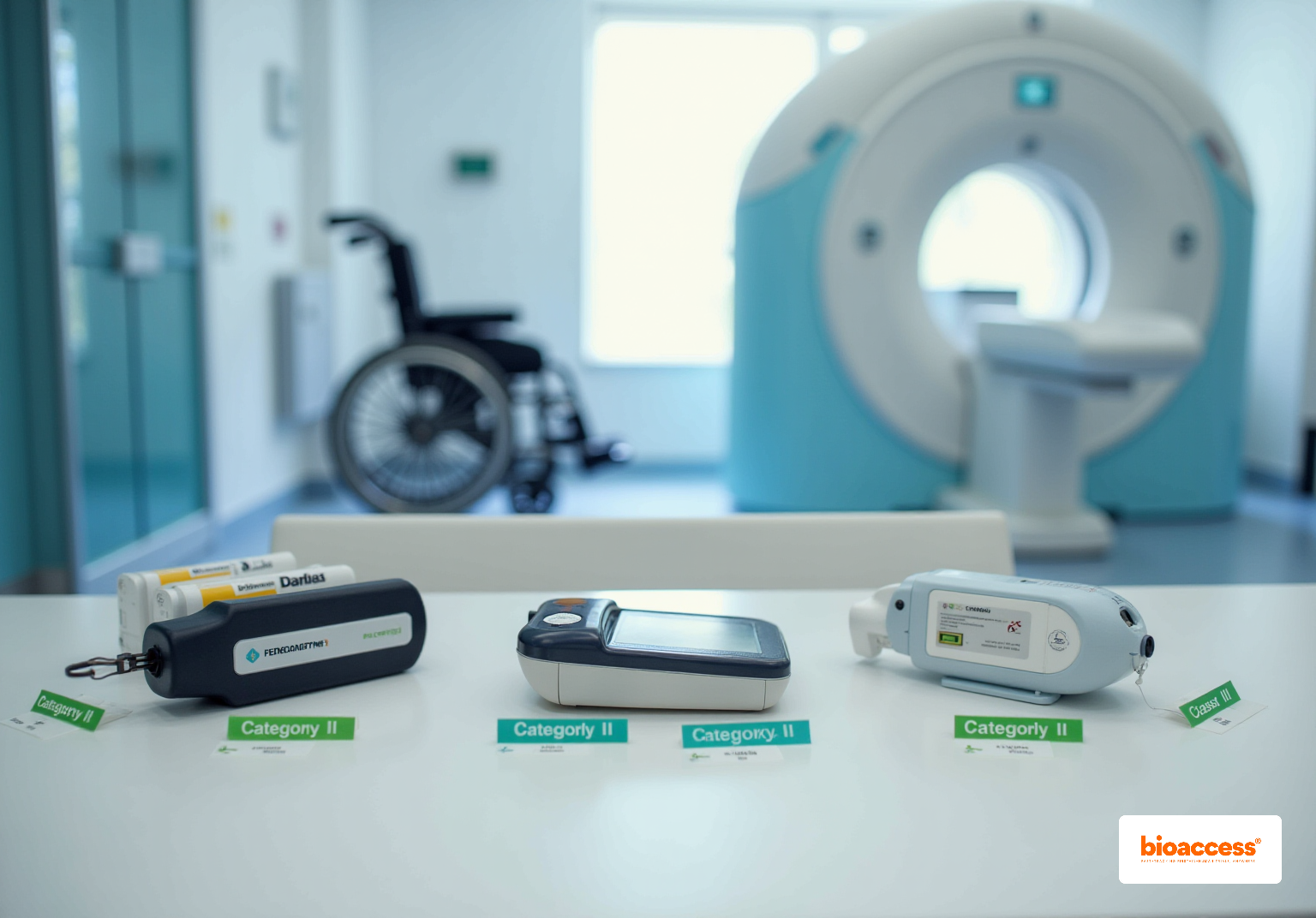


The article provides a comprehensive overview of the classification of medical devices, categorizing them into three distinct classes:
This classification is grounded in their respective risk levels and regulatory requirements, which are crucial for effective healthcare delivery.
Understanding the classification of medical devices is crucial in a landscape where patient safety and technological innovation intersect. Instruments range from simple bandages to complex surgical robots, and the implications of these classifications extend beyond regulatory compliance; they directly impact patient outcomes and healthcare quality.
However, what challenges do manufacturers face in navigating the FDA's intricate classification system? Furthermore, how do these categories influence the development and approval process of medical devices?
Healthcare instruments encompass a diverse array of tools, apparatuses, machines, and software designed for health-related purposes, playing a pivotal role in the prevention, diagnosis, monitoring, treatment, or alleviation of illnesses. Their range is extensive, spanning from fundamental items like bandages and thermometers to advanced technologies such as pacemakers and MRI machines.
The significance of healthcare instruments in the medical field is profound; they are indispensable in enhancing patient outcomes and improving the quality of care delivered. For instance, the diagnostic imaging sector alone constitutes 20% of the overall healthcare equipment market, underscoring its critical function in accurate disease diagnosis and management.
Furthermore, advancements in healthcare technology, including AI-driven surgical robots, have proven to enhance precision and reduce recovery times, thereby improving overall patient care. Understanding the classes of medical devices is essential for ensuring their safety and efficacy in clinical settings, which ultimately contributes to better health outcomes for patients.
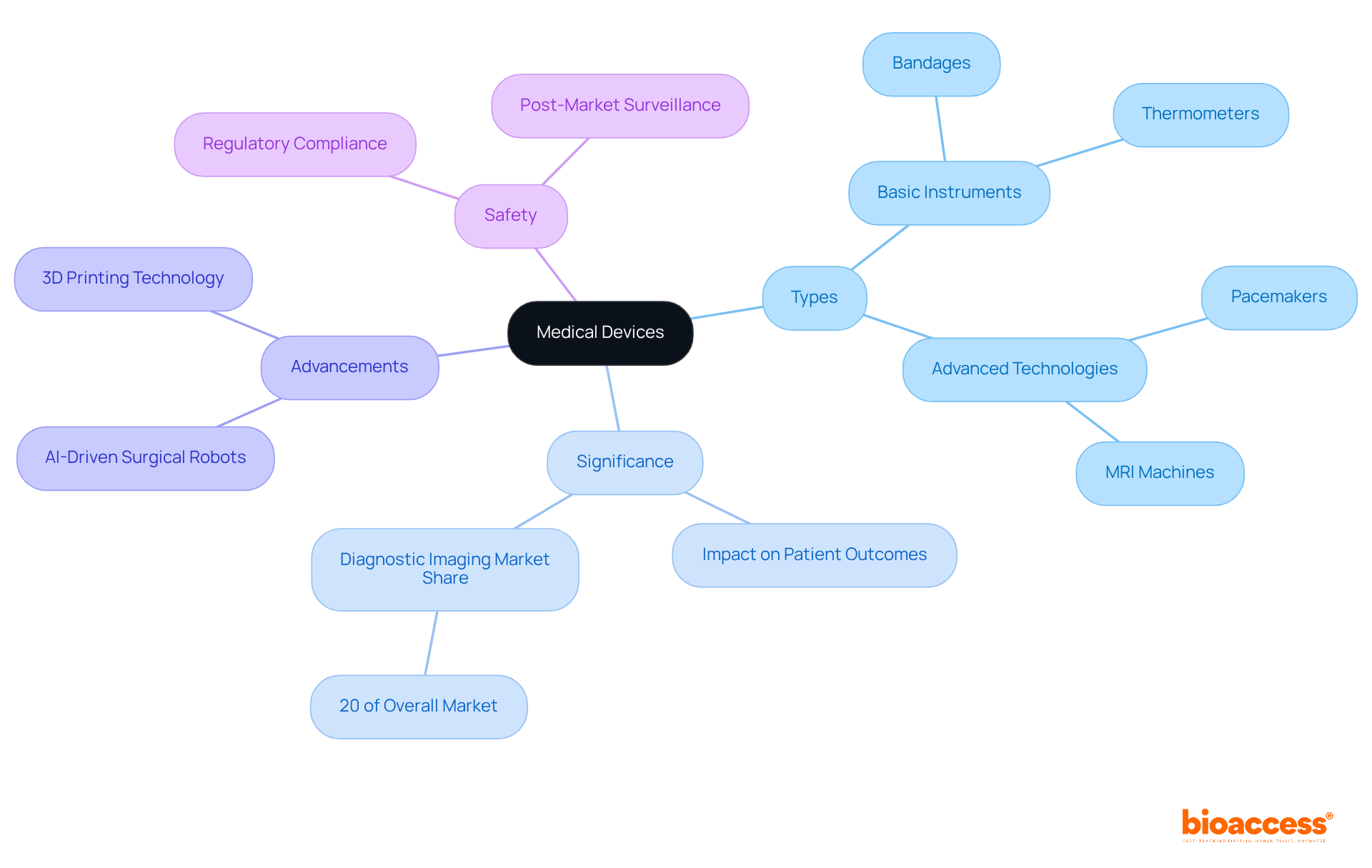
The FDA categorizes medical instruments into three distinct classes of medical devices based on their risk to patients and the necessary regulatory measures. This classification system is essential for ensuring the safety and effectiveness of tools intended for public use.
Category I Devices: These are classified as low-risk and are subject to general controls, which encompass proper labeling and adherence to manufacturing practices. Approximately 50% of healthcare tools fall into this category, frequently including straightforward designs without moving components, such as adhesive bandages and manual stethoscopes.
Category II Instruments: Representing around 43% of medical instruments, Category II instruments present moderate risk and necessitate additional specific controls. These controls may involve performance standards and post-market surveillance. Examples include powered wheelchairs and infusion pumps, which require a 510(k) premarket notification to demonstrate substantial equivalence to existing products.
Class III Products: These high-risk items, constituting about 9% of the industry, are subject to the most stringent regulations and require a Premarket Approval (PMA) process. This process demands extensive scientific data to ensure safety and efficacy prior to market entry. Examples include cardiac pacemakers and deep-brain stimulators, which undergo rigorous clinical trials.
Understanding the FDA classification system is crucial for producers, as it significantly influences compliance protocols, the types of premarket submissions required based on the classes of medical devices, and the overall timeline for launching a healthcare product. Recent modifications in FDA regulations have further underscored the importance of human factors engineering (HFE) processes, particularly for Category II and III products, to effectively mitigate use-related risks. As the landscape evolves, manufacturers must adeptly navigate these complexities to ensure successful product launches while maintaining compliance.
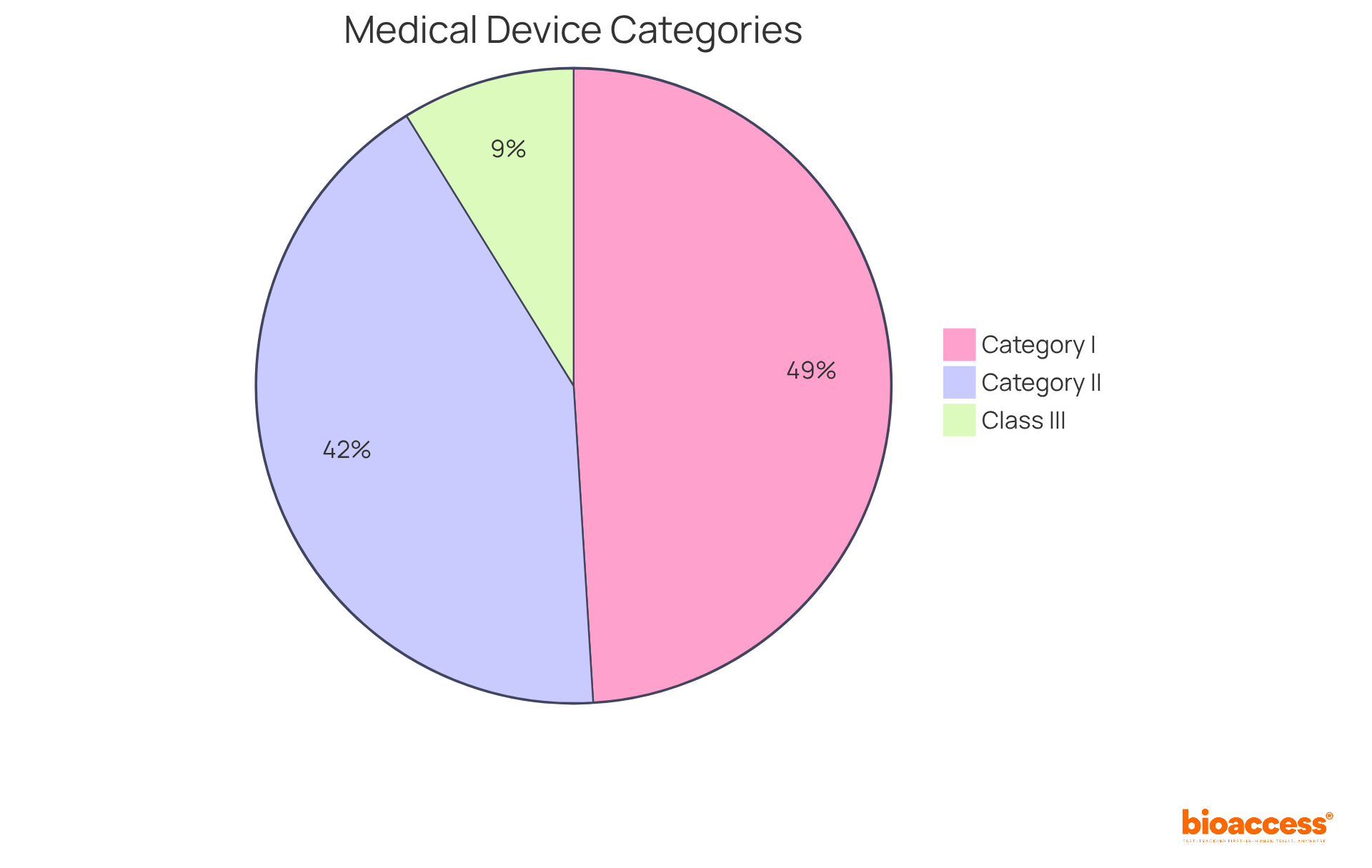
Classes of medical devices include Category I medical products, which represent the lowest risk classification and encompass items such as bandages, handheld surgical tools, and non-electric wheelchairs. These products are generally exempt from premarket notification obligations, enabling faster market entry. In contrast, the classes of medical devices include Category II products, which consist of powered wheelchairs, infusion pumps, and diagnostic imaging equipment, necessitating a 510(k) submission. This submission demonstrates that the apparatus is significantly comparable to an already available product, ensuring adherence to safety standards. Notably, Category II instruments comprise approximately 43% of all medical equipment in the United States, underscoring their prevalence in the healthcare market.
Class III instruments are categorized within the classes of medical devices, including pacemakers, defibrillators, and breast implants, and are subject to the most stringent regulations due to their higher risk profile. These instruments require a premarket approval application (PMA) to confirm their reliability and effectiveness through extensive clinical data. Recent developments indicate a growing emphasis on the importance of clinical evaluation under the Medical Device Regulation (MDR), which mandates manufacturers to analyze alternative treatments and consider post-market data to demonstrate the benefit-risk ratio.
Industry leaders emphasize the critical nature of the classes of medical devices. For instance, the Medical Device Coordination Group (MDCG) has highlighted the necessity for manufacturers to adhere to general security and performance requirements established in Annex I of the MDR. Practical examples of Class II instruments include infusion pumps and powered wheelchairs, which must comply with the 510(k) submission procedure to guarantee their effectiveness and reliability. Furthermore, extensive clinical trial management services, such as those offered by bioaccess, are essential in facilitating the feasibility studies, site selection, compliance reviews, and project management required for the successful development and approval of these medical products. This organized classification system not only assists in regulatory compliance but also enhances patient safety by aligning risk with appropriate oversight.
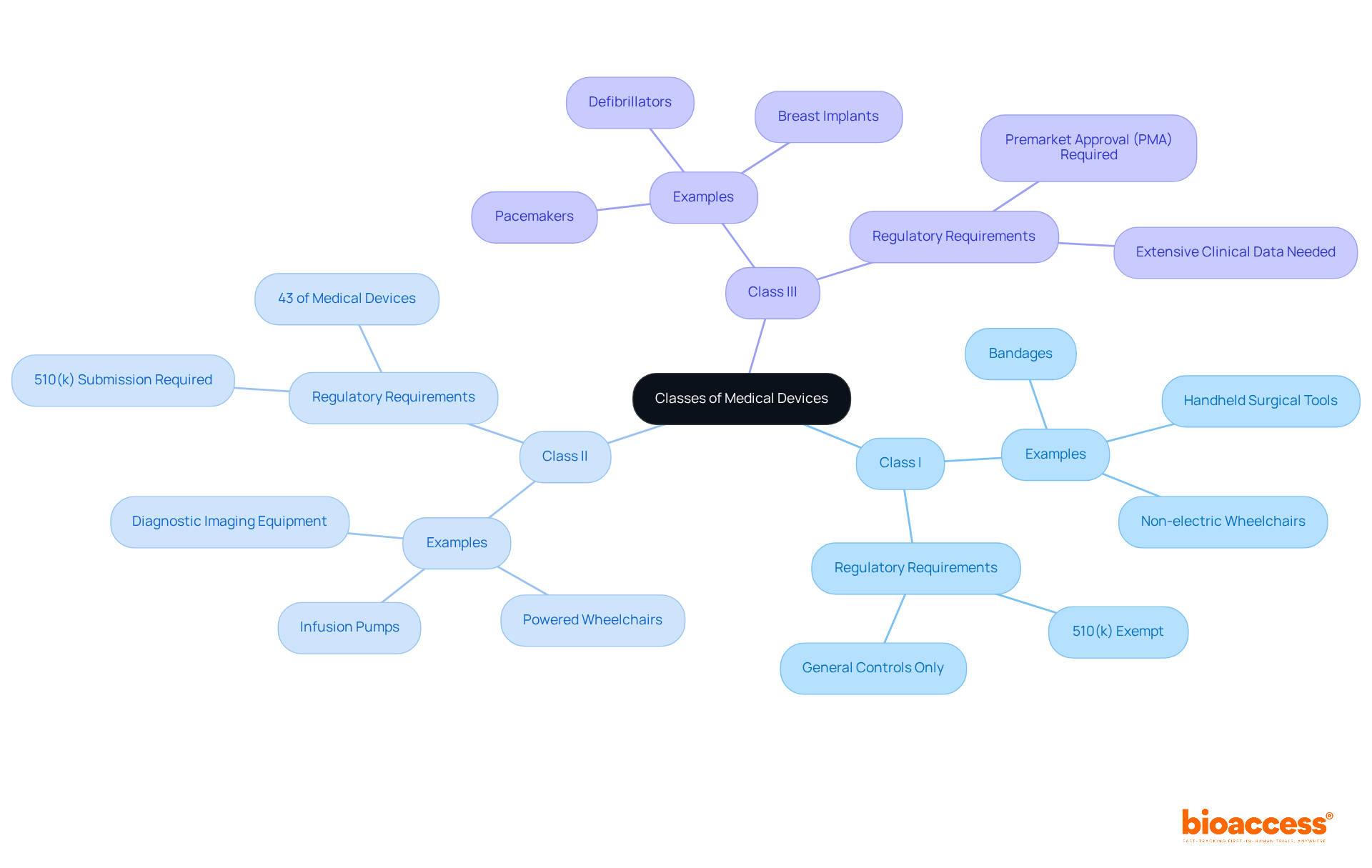
Producers of Category I products, part of the classes of medical devices, are required to adhere to general regulations, which encompass appropriate labeling, quality production practices, and registration with the FDA. Conversely, the classes of medical devices that are categorized as Category II instruments necessitate compliance with both general and special regulations, potentially including performance standards, post-market monitoring, and specific labeling requirements.
To demonstrate substantial similarity to an existing apparatus, manufacturers must submit a 510(k) premarket notification. Notably, recent statistics reveal that approximately 32 percent of FDA 510(k) submissions failed the acceptance for review check in the year leading up to September 2022, underscoring the critical importance of accurate submissions.
Classes of medical devices, such as Category III products classified as high-risk, must navigate the rigorous premarket approval (PMA) process, which involves extensive clinical trials to ascertain safety and effectiveness. This regulatory framework is essential for protecting patients and ensuring that various classes of medical devices meet stringent quality and performance standards.
For example, classes of medical devices, including Class II devices such as infusion pumps, often require comprehensive testing and documentation to satisfy special controls. Engaging expert regulatory support is vital for manufacturers to effectively navigate these complexities and minimize delays in the approval process.
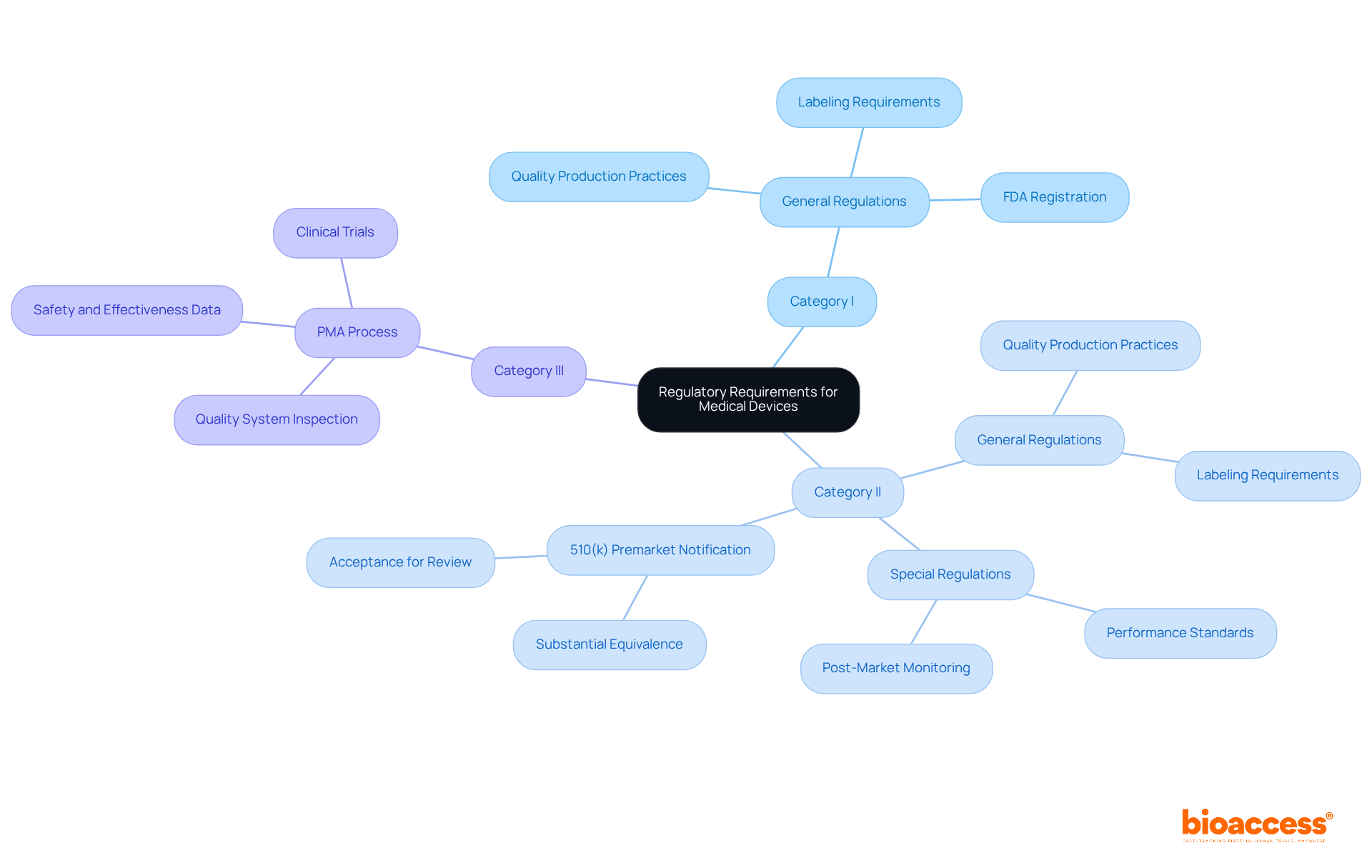
Understanding the classification of medical devices into Classes I, II, and III is crucial for ensuring their safety, efficacy, and compliance within the healthcare sector. Each class serves a distinct purpose, reflecting the varying levels of risk associated with different medical instruments. This classification streamlines regulatory processes and enhances patient safety by aligning the necessary oversight with the inherent risks of each device.
The article delves into the specifics of each class, highlighting that:
These insights emphasize the importance of understanding these classifications, as they directly impact compliance protocols and the timeline for product launches.
In conclusion, the classification of medical devices is not merely a regulatory formality but a vital framework that safeguards public health. Manufacturers and stakeholders in the healthcare industry must prioritize adherence to these classifications and associated regulations to ensure the delivery of safe and effective medical solutions. By navigating the complexities of the FDA's classification system, they can contribute to improved health outcomes and foster innovation in medical technology.
What are medical devices?
Medical devices are a diverse range of tools, apparatuses, machines, and software designed for health-related purposes, including prevention, diagnosis, monitoring, treatment, or alleviation of illnesses.
What is the range of medical devices?
The range of medical devices spans from basic items like bandages and thermometers to advanced technologies such as pacemakers and MRI machines.
Why are medical devices important in healthcare?
Medical devices are crucial in enhancing patient outcomes and improving the quality of care delivered, playing a significant role in accurate disease diagnosis and management.
How significant is the diagnostic imaging sector in the healthcare equipment market?
The diagnostic imaging sector constitutes 20% of the overall healthcare equipment market, highlighting its critical function in the medical field.
What advancements in healthcare technology are mentioned?
Advancements such as AI-driven surgical robots have been noted for enhancing precision and reducing recovery times, thereby improving overall patient care.
Why is it important to understand the classes of medical devices?
Understanding the classes of medical devices is essential for ensuring their safety and efficacy in clinical settings, which ultimately contributes to better health outcomes for patients.